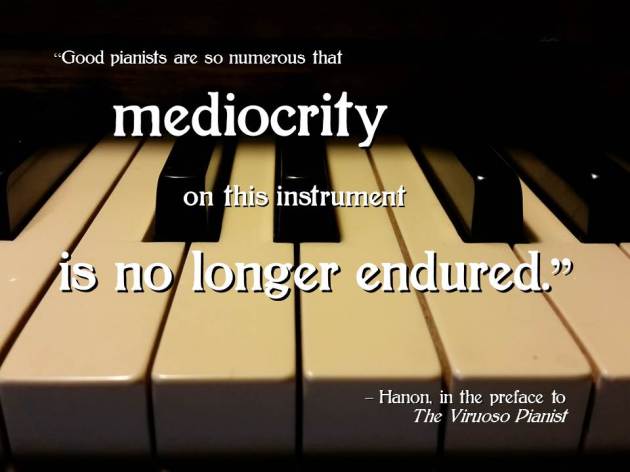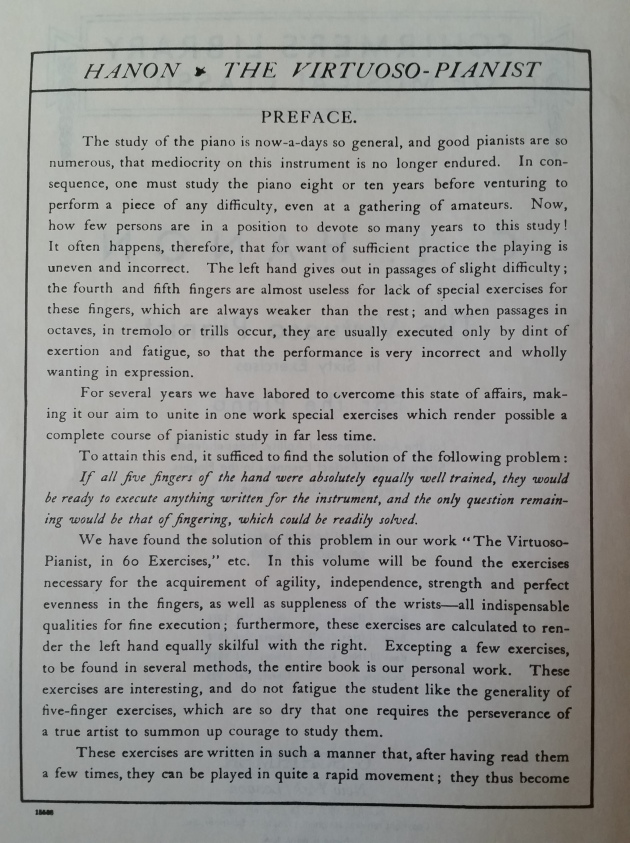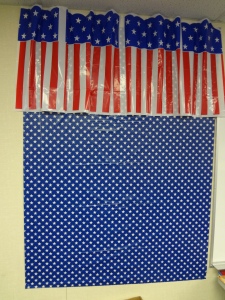Wyatt is a first-year saxophone student, so I am especially proud of his decision to take on this challenging piece. Enjoy!
Mediocrity is No Longer Endured
What a great quote by Hanon!
Here is the quote in its context. Notice the third to last paragraph. I love the irony that Hanon says, in essence, if you haven’t been practicing, you can play this book for “a few hours” and catch up. I’d love to tell my students, “Hmmm. It seems like you haven’t practiced this week. But good news: If you practice these exercises for three hours, you’ll be right back to where you were last week,”
Five Ideas for a Better Beginning Band Winter Concert
If you teach beginning band like I do, you know that preparing for the Winter Concert is a huge challenge. Here are a few ideas to make that first performance a little better.
 1. Use piano accompaniment. Let’s face it: A unison rendition of Hot Cross Buns and Jingle Bells is pretty frightening. Having a piano accompanist who can fill out the harmonies will go a long way in adding color. Ever since I started using a pianist about 10 years ago, I can’t imagine doing it any other way. Hint: Decide on your metronome markings in advance and tell your accompanist. Also, bring in the accompanist at least once before the performance to get the students used to the idea.
1. Use piano accompaniment. Let’s face it: A unison rendition of Hot Cross Buns and Jingle Bells is pretty frightening. Having a piano accompanist who can fill out the harmonies will go a long way in adding color. Ever since I started using a pianist about 10 years ago, I can’t imagine doing it any other way. Hint: Decide on your metronome markings in advance and tell your accompanist. Also, bring in the accompanist at least once before the performance to get the students used to the idea.
2. Feature various instrument groups at the beginning of each song. For example, the clarinets might play Mary Had a Little Lamb alone (with piano) first, and then the rest of the ensemble joins them on the repeat. Hint: Feature your strongest section on your most difficult piece, and a weaker section on an easier piece. For me, that usually means the trombones get featured on Hot Cross Buns, and the clarinets get featured on Jingle Bells.
3. Allow a student to introduce the songs to the audience. You’ll want to select a student with a good speaking voice, not necessarily your best musician. Rehearse their speech with them. (By speech, I mean “Our first song is Hot Cross Buns. It will feature the trumpets.”)
4. Give parents a moment to take pictures while the students are on stage with their instruments. I didn’t start doing this until I had children of my own, and my wife took a gazillion photos of every move they made. Now I appreciate the fact that parents want to capture the moment.
5. Make sure there is at least one administrator and another teacher at the performance. If your concert features more than one ensemble, you need someone to supervise the students who aren’t performing. And if a more serious incident occurs during the performance – like an injury, a squabble among parents, a power outage, etc. – you’ll need an administrator to manage that issue while you lead your performers.
Any other bright ideas? Share them here!
Patriotic Classroom Bulletin Boards
As an elementary music teacher who usually is usually forced to teach on the cafeteria stage, I rarely have the opportunity to decorate bulletin boards. But this summer I am teaching elementary general music, and have fortunately been assigned a real classroom. So I’m stepping far outside my routine by decorating my classroom. Since Independence Day is in the middle of summer school, I’ve decided to go with a patriotic theme.
The small flags are from Oriental Trading Company.
The stars and stripes “valance” is a plastic table cover cut in half lengthwise, also from Oriental Trading Company.
The starry background is a table cover from Michael’s:
The rest of the bulletin board art is from a local teacher’s supply store.
I felt like I was kickin’ it old school style by using the Ellison die cut letters. It would have been easier and maybe even more colorful to have printed out a small banner using Microsoft Word, but somehow the actual cut out letters seemed to fit the look.
Also, I’ve been looking for an opportunity to use this Uncle Sam meme generator, but haven’t done anything yet. Printing out a poster would cost more than I’m willing to spend. Maybe I’ll use it for our end-of-summer-school assembly.
I’m positive that those of you who create classroom bulletin boards on a regular basis could make a ton of improvements to these. Nevertheless, creating these got me into the patriotic spirit.
Happy Fourth of July!
Beginning Flute Dilemma
Do you have a policy or even a personal philosophy about starting beginning flute players? For example, do you wait until they reach a certain age or grade level? Do you require that they play a different instrument first? ![MP900316901[1]](https://stengel99.files.wordpress.com/2011/11/mp9003169011.jpg?w=300&h=200)
Every fall I am faced with the issue that most of my beginning flute players rarely progress at a level anywhere near the rest of my beginning wind players.
I’ve tried discouraging 4th graders from starting with flute. Essentially, I tell the parents of 4th graders that if they want to play flute, they will have to provide their own instrument; I won’t loan them a school-owned instrument. This has probably prevented some problems, but I’m not sure how effectively it’s improved my flute sections.
This year, I took a different approach with teaching fingerings to my beginning flutists. I taught them using the first 5 notes of the concert F scale instead of concert Bb. This eliminated the awkward C to D challenge, and made songs like Hot Cross Buns and Mary Had a Little Lamb more accessible. It’s hard to say how effective this has been.
Somehow, every year I manage to find a gem of a beginning flutist who stays right on track with the rest of the band, or even progresses more quickly than the rest of the class. (And no, it’s not because they have a different private music teacher!) So I don’t necessarily think my pedagogical skills are the issue.
Even with these preventative measures and crutches, I’ve had disappointing results.
Help! Any thoughts?
This is the End
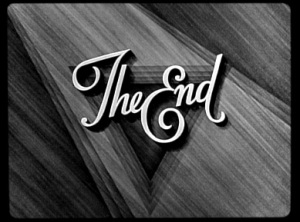 Every teacher has heard it before: Preschool is the foundation for elementary school. Elementary school is the foundation for junior high. Junior High teachers must teach the necessary skills for students’ success in high school, and so on. Each level lays the groundwork for the next.
Every teacher has heard it before: Preschool is the foundation for elementary school. Elementary school is the foundation for junior high. Junior High teachers must teach the necessary skills for students’ success in high school, and so on. Each level lays the groundwork for the next.
Really?
Why can’t the general music class for primary students just be an end in itself? Does beginning band have to function solely as preparation for intermediate band? Can’t each of these ensembles be an enjoyable experience on it’s own?
A few years ago, I started to get discouraged about the percentage of my former elementary students who continue in music in middle school. (I have since learned that much of this is due to scheduling issues, or opportunities for junior highers which elementary schools don’t offer.) As an elementary teacher, have I failed as a teacher if my students choose not to continue to play their instruments in junior high?
Because I teach grades 3-6, I have always tried to prepare for students for the next level in my own program. But in doing so, I wonder if I may be discouraging some students by challenging them beyond their abilities. And I know that in some cases I have discouraged myself by focusing on student’s inabilities rather than celebrating their accomplishments.
In many ways, this issue is related to my resolution to make music classes fun.
Does all this mean I will fail to teach the skills necessary for junior high music? Probably not. But it does mean I will remember to enjoy each moment with my students, to treat them not only as future music majors but as kids who deserve to have fun making music.
Go Away
Okay, I don’t mean that I want you to stop reading this blog.
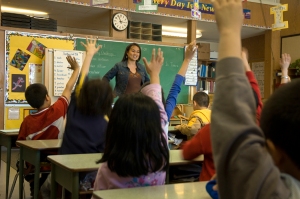 I recently had a chance encounter with my district’s head librarian. Although I may not see her more than a couple times a year, it was a pleasure to see her again.
I recently had a chance encounter with my district’s head librarian. Although I may not see her more than a couple times a year, it was a pleasure to see her again.
She had once given an assembly at a school where I taught, and it was one of the more outstanding presentations I’ve seen. She gave a talk to the students on the art of storytelling. She read aloud from some very colorful books, and she recited some stories from memory. She really captured the imagination of everyone in the audience.
I doubt that giving these assemblies is a requirement of her job description. She could probably get away with spending her days hibernating at the district office, or doing private consultations with the school librarians, and never interact with teachers or students. But her visit to our school site brightened the day of everyone there.
Likewise, my district’s music department has some activities built into the calendar that involve the music teachers “going away” and visiting each others’ students. Every now and then I will see a teacher or student who will see me and say, “Hey, you’re that music guy who came to our school.”
These little meetings and comments have made me realize how important it can be to go away from our usual teaching environments and interact with a different set of people.
I’m brainstorming here, hoping to implement more of this kind of thing into my music classes and my teaching schedule, but here are a few ideas for meaningful “go away” experiences:
- Bring in a collegue for a clinic. This person doesn’t have to be a university professor, just someone else who might have something helpful to offer your students.
- Turn observations into clinics. A younger colleague once came to observe my teaching, but I told my students he was there to listen and comment on our playing. During the final minutes of the class, he made some helpful suggestions.
- Offer to be a guest clinician for a colleague. If you’re a woodwind player, offer to help out a teacher who plays a brass instrument.
- Have your older students work with your younger students. Both sets of students can benefit from this experience. I’ve been amazed at what some of my older students have had to offer.
- Bring in a parent or adult amateur but active musician. One of my student’s grandfathers plays in a recorder ensemble, and their visit to my music class was an enlightening experience.
- Have one of your small ensembles play at a community event. I remember times as a student and as a teacher performing at Rotary Club meetings, corporate Christmas parties, and the like. Those were great opportunities for the music programs to remain visible in the community.
What other ideas do you have for getting out or bringing others in?
Procedures and Routines in the Music Class
I remember once watching my daughter playing school, pretending to be the teacher. She sat in a chair holding a book up to her class of stuffed animals. She showed her class the book, and said “Front cover, back cover, spine, title page, dedication…” 
It was obvious that she had learned the parts of a book through a routine of her teacher. It struck me how important these kind of routines are for music classes and private lessons.
Anyone familiar with the book The First Days of School knows that this is the holy grail of teaching prodecures and routines at the beginning of the school year. This is certainly one of few books that apply to music classes as well as the traditional classroom.
Here are some classroom management issues to consider:
-Where do students put instrument cases?
– Music stands and chairs: Does the teacher set them up? Do the students get them from a rack? Does everyone get their own music stand? What equipment gets put away and who does it?
– Books and sheet music: Do students take everything with them, or is there a folder storage system? Larger ensembles may need a librarian, or at least section leaders who can help distribute sheet music. What about when they forget their folders or misplace sheet music?
– Are students allowed to play their instruments before the ensemble warm-up?
– How do students know the rehearsal/warm-up has officially begun?
Here are some routines I’ve been implementing with my groups:
For beginners:
– Identifying the parts of their instrument, admittedly ad nauseum
– Assembling their instruments and explaining/verbalizing the process for doing so
– Verbalizing the fingerings for their first notes (Beginning Band: Concert Bb – F; Beginning Strings: D Major scale)
– Identifying notes on the staff, using flash cards
For intermediate students:
– Band: Simple warm-up exercises such as those on Essential Elements Book 1, page 18
– Strings: The D Major scale with simple rhythmic variations and bowing patterns
– Rhythm exercises, clapping and counting aloud
For private students:
– Scale/arpeggio exercises appropriate to the student’s ability
– Warm-up notes for beginners
– For younger students: A review of previously practiced music
– Introduction of new music/exercises
– For older students: Repertoire development
– A clear expectation of what is to be practiced for the next lesson
What procedures and routines have you used in your music classes that you would recommend to the rest of us?
New School Year’s Resolution: Fall 2010
My New Year’s resolution this fall is to keep music classes fun.
The issue of music being fun has been brought to mind through several different sources.
First, it’s no secret that classrooms have become less fun in recent years. It’s true that students may always complain about school not being fun, but now experienced teachers are now protesting as well. Many fun, creative lesson plans have been eliminated because they don’t fit into today’s curriculum. The word “enrichment” has come to mean “dispensable.”
As music teachers, we are fortunate that for the most part, we have a certain level of control over what we teach and how we teach it. I hope to make the most of that freedom by keeping the experience fun for students.
Second, I have been reminded about how fun music can be by those outside the traditional band/orchestra setting. (More about this in future posts.) For now I’ll just say that when adult amateur musicians talk about playing, they talk about how fun it can be. By contrast, sometimes I find myself getting too stressed out by learning or teaching music, so I know my perspective is off.
Third, I’ve been reading about the importance of laughter. Laughing has all kinds of benefits which I won’t get into here. It seems laughing even has health benefits, releasing endorphins and possibly reducing toxins in our bodies. In the classroom, sharing a laugh can break down the psychological defenses students build up when they’re in stressful environments. In brief, laughing can free us up to learn more effectively.
Finally, when you hear people talk about past musical experiences, their eyes often light up as they talk about how fun it was. Whether it’s an adult reminiscing about their musical past, a high schooler talking about their elementary music experience, or a group of performers who have just come off the stage, people love to talk about how much fun they’ve had making music. If you’ve read Steven Covey’s work, you know about beginning with the end in mind. I want the end to be students having fun.
Sure, all of this fun needs to be balanced with discipline, developing new skills, learning new concepts, being challenged, etc. Personally, I’m not worried about forgetting to teach those concepts in classes. But I want to remember to have fun along the way.
Marching Band Enters the World of New Media
OK Go – This Too Shall Pass from OK Go on Vimeo.
The relevance of marching band and traditional band programs has been the subject of many a blog in recent days.
Here’s an impressive video by a very creative marching band. This is one way to incorporate 21st century media into a marching program!
Although this is a college band, I can imagine the excitement a high schooler would have knowing their creativity was going on YouTube rather than just ignored during halftime.

